|
|
|
|||
|
|
||||
|
|
||||
| Smoke Trails | ||||
|
|
HOME | SITE MAP | FORUM | CONTACT |
|
||
|
ABOUT | MOTORS | MODELS | ARCHIVE | HISTORY | STORE | FAQ | LINKS
|
|
|
|
|
|
||||||||||||||||||||||||||||||||||||||||||||||||||||||||||||||||||||||||||||||||||||||||||||||||||||||||||||||||||||||||||||||||||||||||
|
Smoke Trails 10
(March 2007)
by Roger Simmonds Originally published in SAM 35 Speaks, March 2007 Model Miscellany Hubert Kostrzewa’s plan for the feisty Rapier L-2 powered MiG 17 discussed last month is a good example of modern jet design (see below right): note the closely spaced wing ribs, ‘geodesic’ bracing and light but stiff tailplane construction. The motor is enclosed and hidden in a deep trough. Nevertheless, the design pays more than a little homage to its illustrious antecedent – Bill Dean’s MiG 15. A MiG 19 would make an interesting comparison, and complete the MiG ‘15-21’ set. Any takers? |
|
||||||||||||||||||||||||||||||||||||||||||||||||||||||||||||||||||||||||||||||||||||||||||||||||||||||||||||||||||||||||||||||||||||||||
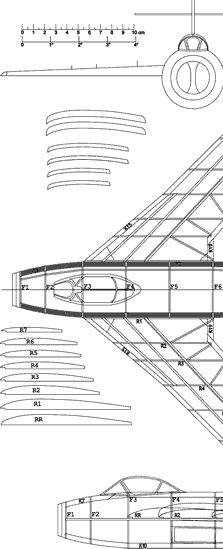
Like the MiG 17, the Marty Richey has built both the |
|
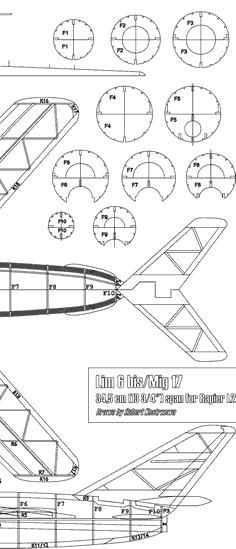 Hubert Kostrzewa’s plan of his MiG 17 for Rapier L-2 power |
|||||||||||||||||||||||||||||||||||||||||||||||||||||||||||||||||||||||||||||||||||||||||||||||||||||||||||||||||||||||||||||||||||||||
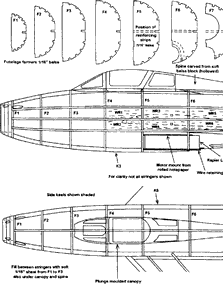
Steve Bage has also built an F-84 (below right), and confesses, “Mike's plan is for the Thunderstreak fighter, but I can’t resist messing with a perfectly good design […] I modified it to the PR ‘Thunderflash’, which had air intakes at the wing roots and a longer nose. As Mike wanted it to be a good beginner’s subject, the plan shows a hint of dihedral, but I built the wing flat. I did attempt to shrink in a little washout during covering and doping [tut tut, not built in?] but the diagonal bracing of the wing makes it so stiff that it wouldn’t retain any ‘twist’”. Steve sensibly believes in flight-testing au naturel (the models, not himself), and, having discovered three motors hiding in the corner of his flight box, was ready to visit his local proving grounds. |
|
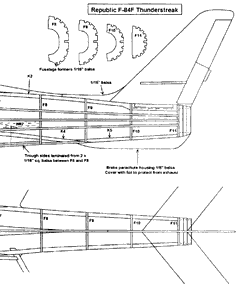 Mike Stuart’s plan of his Republic F-84F Thunderstreak |
|||||||||||||||||||||||||||||||||||||||||||||||||||||||||||||||||||||||||||||||||||||||||||||||||||||||||||||||||||||||||||||||||||||||
|
|
|
|||
|
Steve reports: “About 1 g of nose weight produced a nice glide, so I dropped in the first motor. It flew ‘right off the board’. There was quite a tight right turn under power, but it produced a perfectly acceptable flight even in the stiff breeze. For the second flight, I added a trim tab on the rudder to take out some of the turn. Unfortunately [Steve was trying to video the flight as well!] I chucked too steeply and it went up into a stall followed by a couple of low altitude loops. For the third flight, I added a touch more nose weight and was rewarded by a near perfect flight. It flew quite briskly on 120 mN of thrust, gaining good height, and the glide was especially good. I thought I was going to have a very long walk to recover the model; fortunately the glide was straight into the breeze and it ended up not too far from the launch point. It would be great to see a few more of models based on Mike’s plan being built, as, from my own experience, it is an ideal beginner’s subject – the build is straightforward, it appears to be robust, the flying characteristics are perfect and it shows no sign of any spiral instability”. Wonderful stuff, Steve: you are obviously a ‘Prime Pilot’! Please contact Mike if you would like a plan. Steve is now finishing his model, for which a plethora of flamboyant, if overly complex, paint schemes are available. |
 Thunderflash for Rapier L-2, adapted by Steve Bage from Mike Stuart’s Thunderstreak plan (above).Covered and doped, but unpainted, it weighed 27 g for the first test flights.
- Steve Bage
|
|||

It will be interesting to see how Steve gets on with this one – Richard Crossley built a scaled down version some time ago, and found, when trimmed in his usual fashion, that is, with the CG well forward for a flat glide, it had a nasty tendency to spiral in. I’m not sure it needs reducing: Richard thought his ‘DH 110 lite’ was overpowered, and Graham Potter’s large Easy Built Venom goes well, if in a stately fashion, with a standard L-2. As the KK DH 110 has recently appeared as a Replikit, and others are building it ‘as is’, we should be able to make some informed comparisons of the flying characteristics of the ‘large and small’ versions, especially if the flights are captured on video (see later). |
|
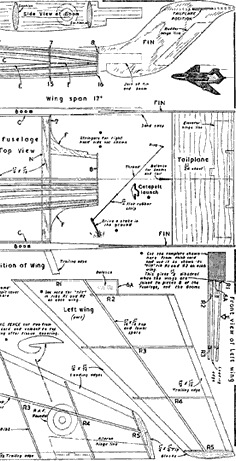 Keil Kraft DH 110
- Designed by Albert Hatfull
|
||
|
Whether to scale down (or up, for that matter), and by how much, is not the only conundrum posed by old models. Many are “not even accurate enough to be wrong”. Bill Dean’s KK MiG 15 is a case in point. Take a look at the position of the tailplane, for example. Hubert’s MiG 17 is better in this, and many other, respects. Howard Metcalfe opines that some kit designers “just didn’t care”, and wonders why this was so: was it indolence, lack of access to decent 3-views, or commercial pressures? However, plans are not sacrosanct, and modification to suit one’s own predilections or to (hopefully) improve handling characteristics is perfectly in order. The problem is knowing how far to go before one becomes obsessive and goes mad or receives a knock on the door from the SAM PC brigade. Steve bravely overlaid the DH 110 plan on a modern 3-view … and was surprised and pleased at how accurate it actually is. The main discrepancy is the section of the tail booms: being made of ¼" balsa sheet they are too flat, but Steve thinks this is one compromise he can live with, adding, “It would be quite easy to adapt the design to the production Sea Vixen, but I like the prototype better, so I’ll stick with it”. He did, however, decide to add a few more wing ribs … and found that, after drawing the new wing layout, it was difficult to stop fettling: “The wing section is rather strange, being virtually symmetrical in both the horizontal and vertical axis [?]. In practice, this may work fine, but I can’t bring myself to use it; so I’ll draw up a ‘proper’ wing section transitioning from near symmetrical at the root to ‘Clark Y-ish’ at the tip. I’ll also build in a little washout and tweak the fuselage formers to match the new wing root”. A discussion of airfoils and how, or why, they work at these scales (or indeed at any scale) is for a braver person than I. I will only comment that the Flitzer, a similar twin-boom design of unimpeachable flying characteristics, has a flat bottom 10% airfoil and a sharpish leading edge, and this appears to work well on most small models. However, the rounded leading edge and ‘Phillips’ entry’ of the Skyleada Hunter and Steve’s own DH 108 seem to do their flying characteristics no harm at all. Perhaps if the DH 110 is trimmed for a more floaty glide than was usual some years back it will keep its nose up in a turn and avoid the dreaded ‘death spiral’. |
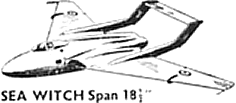 Keil Kraft’s publicity for their DH 110 curiously called it a ‘Sea Witch’
- Keil Kraft brochure, c. 1960
|
|||
Howard and I have been watching Mike Stuart’s latest DVD video, ‘Flying Scale Models 2006‘ (right), which features a goodly number of jets flying splendidly, and – of more forensic, if morbid, interest – behaving badly, which they can all do from time to time. I can only watch these ‘snuff’ videos through my fingers, but Howard Metcalfe, being made of sterner stuff, sat stoically through the carnage, occasionally switching to ‘slow motion’ in order to study the pathological behaviour more closely. He then made some most pertinent observations; viz:
|
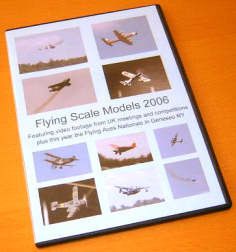 Mike Stuart’s 2006 Flying Scale Models DVD |
|||
|
But would it work for all models? One particularly recalcitrant model is Mike’s Skyleada YF-100 (right). Now I really like this one, and it’s on my ‘to do’ list, but, built as the plan, it appears to be all but unflyable, flopping about, says Mike, “like a freshly landed fish”. I wondered if it suffered from the ‘inertia coupling’ of the full-size prototype, (cured by increasing the fin area and extending the wing tips), but Steve Bage believes the situation is worse than this. He writes: “The motor is too far forward, leading to big trim change between the initial launch and ‘re-launch’; it needs to move back to straddle the CG and any nose-up pitch is then dealt with by downthrust. Secondly, the way the model pitches up into a deep stall then sinks to earth, or flips over backward, is without doubt due to tip stalling. Swept wings tend to do most of their lifting at the tips and are especially prone to this phenomenon. Since the tips are aft of the CG, when they do stall, a nose-up pitch results. This was a serious problem on the full size F-86 and YF-100, so the behaviour of Mike’s model, the so-called ‘Sabre Dance’, is actually authentic! The simplest fix would be to build in a stack of washout, maybe 4 or 5 degrees. I’m pretty confident that these modifications the model would fly in a much more predictable manner.” The notorious ‘Sabre Dance’ afflicted the F-86 more than the F-100 (which did, however, suffer from aileron reversal, so lots of washout might not go down (or up) too well), but I take Steve’s point. Some serious modifications to incidences and thrust lines will have to be made to this model, which was, after all, produced as a kit. Perhaps Pete Smart was correct when he wondered if the later Skyleada models were ever test flown! I will build my ‘Hun’ the correct size, but I will add extra fuselage stringers and sheet some areas. Perhaps a little more weight will not go amiss: one school of thought has it that the faster your model flies, the more stable it is. There are of course not a few impressive jet flights in Mike’s video; Mike’s own Saab Tunnan for Rapier L-3 is a star performer. It certainly impressed Howard, who only wished that the L-3 had a longer burn time. Amen to that!! |
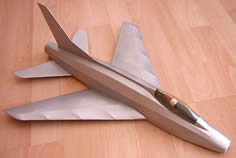 Mike Stuart’s Skyleada YF-100
- Mike Stuart
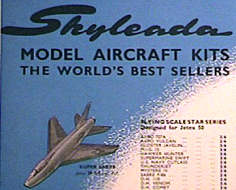 Advertisement for YF-100 Skyleada (3/6d.)
- Model Aircraft
|
|||

I hope this will encourage others to build larger jets. Andy Blackwell, no stranger to large models – his Skyleada Comet for Jetex 100 is a great flier – has seen the Tunnan fly and is keen to build the Skyleada Skyray (right) at its original size. This Ray Booth design is superior to most of the later Skyleada jets (designer(s) unknown). Its unique selling point is that it was intended for the Jetex 100. Andy is fortunate in having several of these motors, which have at least the thrust of an L-3, and (fulfilling Howard’s wish) a longer duration. The Skyray is an attractive prototype; if you haven’t got a Jetex 100 with fuel and spares, and don’t want to be dependent on the vagaries of supplies of L-3s, there were kits from Keil Kraft, Wilmot Mansour (a very nice ‘Tailored’ design) and Comet (below). The latter is perhaps the most true-to-scale, but, in common with the other designs from this stable, it is somewhat over-engineered. If you fancy a modern and accurate design of the Skyray for L-2, then Mike Stuart’s, first published in the (now, alas, defunct) Flying Model Designer and Constructor Vol. 8 No 3 is the one to go for. |
|
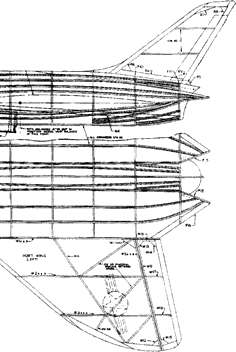 Skyleada Skyray plan (detail) : not particularly accurate, but makes up for this by its size. Note the angle of the Jetex 100.
- Designed by Ray Booth,
for British Model Aircraft Mfg Co. Ltd |
||
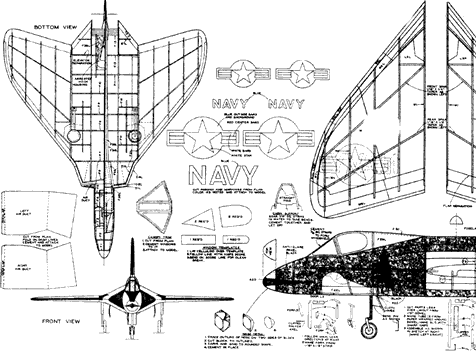 The 1928 Rocket Racer |
|
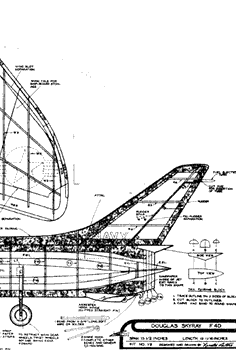 |
||
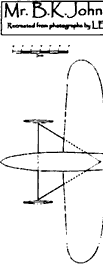
Leigh Richardson, whose recreation of Tim Hervey’s 1948 Jetex Zephyr graced the skies of Old Warden a couple of years back (see (Jet)X Files, August 2004) has produced a 3-view of a B K Richardson’s ‘Rocket Racer’, which was flown ROG at the 1928 Hendon Speed Trials … to instant destruction, powered by a “6 oz thrust rocket motor”. Little else is known about this futuristic 22" model, which was, apparently, “all balsa”; (it’s very early to be so, if this was indeed the case), and I’m not surprised it crashed with 1.5 N of thrust behind it. An L-2 would have been much better. Has anyone got a better photograph than the very poor one from which Leigh derived his plan, or any more data on this model and its formidable motor? The True Story of the Latter Days at Velojet John Reid’s reminiscence of Velojets in Smoke Trails 8 (which had been reprinted from a 1980s Pssst Off Sheet) resulted in a most welcome email from the author himself: “I was very surprised to see my words from long ago in your Jetex column. The story I gave Roger Wathen did rather a disservice to history. I thought my words might have got back to Ivan Harrington [inventor of the Velojet] and, as I didn't want to hurt his feelings, I bowdlerised the story a bit. “However, Ivan died long ago, so I can now give a more objective account of my encounter with Velojet and my small part in the last days of Velojet. |
|
 The somewhat over-powered 1928 Rocket Racer. This ‘all balsa’ model predated Howard Boys’ efforts by almost twenty years
- Leigh Richardson
|
||
|
“I never knew the early Velojets, as advertised in Aeromodeller [right] [and reviewed Model Aircraft, March 1955; see (Jet)X Files, December 2004], but I remembered Jetex fondly, because as a 10 year old I designed and built many varied deltas, canards, saucers etc for the Jetex 50. They generally flew quite well – in contrast to rubber ones that didn’t. So, when I saw little jet motors at the local model shop in Nelson in the late 1980s, I eagerly found out where they came from and visited Ivan at his ‘Skunk Works’ – an old caravan in his back yard. “Ivan had been an engineer with Mount Cook Airlines in the 1950s, and when he first saw a Jetex motor, he was impressed by the high price that people would pay for such a simple device and thought that he could do as well or better. Friends at Otago University analysed Jetex fuel pellets and found that they were largely wood flour [this will come as a surprise to Dr Hutchison – perhaps these were ‘V-Max’ pellets?]. So Ivan designed his own motor and had some fuel made (or made himself, I’m not sure). About 3,000 motors were made in the fifties and marketed by the ‘Betta Model Aeroplane Supply Company’ (right). According to Ivan, one of his motors set a New Zealand record (more of which later). “At this time (the late eighties), a retired engineer had made a new batch of motors for him, and Ivan demonstrated them for me on his test rig, which consisted of a counterbalanced rotating arm fastened to his bench top. I was impressed both by the violence and the smoke. The whole caravan shook! “The design of the motor had some interesting features; for example the safety valve, where a screw threads into the mount and a spring holds a washer against holes bored in the front of the motor. If the orifice is blocked, the over-pressure lifts the washer against the spring. There are no fuses, asbestos washers or gauzes, and the combined mount and safety valve is positive and easily adjusted – well, the mount is anyway. I’m not so sure of the safety valve, which is corroded into one piece in my example. Neither was a local research institution, which would have nothing to do with Ivan’s motors, even though one of their senior managers was the president of our local model aero club. One might have hoped he would be more sympathetic. “[At this time] Ivan made the fuel himself in his caravan. The main ingredient was [still] wood flour; I’m not sure what the oxidiser was (I think Ivan mentioned ammonium and potassium nitrate) but it was sold as fertiliser in small pellets and ground finely in an electric coffee grinder. The mixed oxidiser and wood flour were compressed and shaped in a solid steel cylindrical billet about 150 mm diameter by 200 mm long. This had two holes [within] the internal diameter of the motor, bored through it longitudinally, and sat upright in a rotating fitting so that two plungers could be driven into alternate holes when the billet was rotated 180 degrees. The device was driven by a 15-ton hydraulic truck jack. The procedure was: measure the dry mixed ingredients into one hole, pump the jack, release, rotate the billet, put more ingredients in the second hole, which was now to the front, then pump the jack again. Thus, a second pellet was made at the front whilst ejecting the first at the back. The fuel was of variable quality; one of my remaining pellets is too long and the other is wonky [see photos]. In fairness, these are the only ones I have left and may have been rejects. “To ignite a pellet one lit a corner with a match, inserted it, and screwed the motor together. This was just possible if you had asbestos fingers, the dexterity of a card sharp, were lucky enough to have one of the few motors that had reasonable threads, and were Ivan Harrington. While the pellet is exposed, it merely smoulders, but once enclosed in the motor, the temperature, pressure, and burning rate increases very rapidly. You didn’t have much time! In my original note to Roger Wathen, my English deteriorates when I describe the episode where a cap blew off as I was holding the model in the launching position. I was probably still shaken! “For a moment, I thought I was blinded, as a blast of hot fragments hit me in the face. The motor end cap was never recovered and is probably still in orbit. Ivan said it was my own fault because I couldn’t have screwed the end cap right home. Ivan was astonished when I told him that most customers would not be all that impressed by the mighty power of his little jet, and would prefer less power and a longer run. He assured me that if that was indeed their desire, then it would be no trouble to include an inhibiter to slow the burning. However, the ‘inhibited’ fuel he gave me only sputtered fitfully, developed virtually no thrust, and went out prematurely. Ivan then said he needed Fuller’s Earth. This I obtained for him, but he died before it could be tried. Would it have worked? Maybe. I don’t know what happened to the ‘Skunk Works’. His inventory of motors, about three litres of Velojets, was kept in a small plastic bucket. They must be out there somewhere. “The plane I built for the Velojet was a profile tail-less sort of DH 108 Swallow of 16" span with light 1/16" flying surfaces and wing-tip fins. The motor was mounted on top of the 1/8" balsa fuselage. The climb in the first flight rapidly got steeper and it accelerated vertically into a loop, the motor burning out about three quarters of the way down. The motor run was 3 seconds at the most, but it sure went some while it lasted and caused the audience great consternation! Flutter developed on a subsequent flight and the model emulated the demise of the original Swallow.” “Oddly enough, Ivan’s claim of a record may be plausible. In the 1950s, Jetex duration competitions were based on the ratio of glide to power time. Ivan’s motor, with its short burst of high power, would have turned a chuck glider into a boost/glide rocket and result in a glide/power ratio far better than a Jetex. “Was the Velojet ever a credible alternative to Jetex? I doubt it, but someone should investigate further. Isn’t it strange how difficult it has been to come up with an equivalent to Jetex? We need a small, cheap power unit that youngsters can attach to simple airframes that they can design and make themselves. Maybe old youngsters would play too. At the moment, the best hope seems to be a well-packaged electric ducted fan, but we would miss the smoke and burned fingers.” Many thanks, John, for sharing this fascinating story. Ivan sounds quite a character. It is most remiss of the review of the Velojet 50 in ‘Over the Counter’ (Model Aircraft, 1955) that it didn’t mention, let alone comment on, the curious method of ignition or the high thrust and short duration of the motors. Perhaps the early motors differed from the later ones. Wood flour with ammonium nitrate is not really a viable alternative to guanidine nitrate for our purposes; the fuel Ivan developed was different from the ICI and Sebel products and closer to those of the inferior V-Max and Powermax products. |
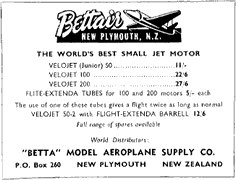
- Aeromodeller Annual, 1955
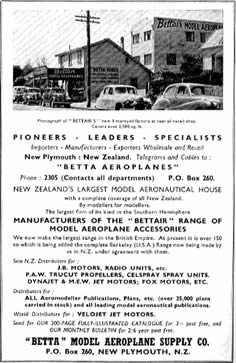 A 1957 advertisement showing the ‘Betta’ premises – rather more substantial than Ivan’s caravan
- Aeromodeller Annual, 1957
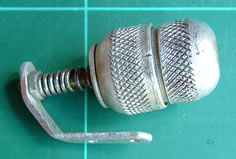  The late model Velojet with fuel pellets, compared to a Jetex 50C
- John Reid
|
|||
Below is a facsimile of the original instructions. On the back (right), printed by what is obviously a cheap rubber stamp (and one wonders what circumstances or threat of litigation compelled Ivan, who obviously had a relaxed attitude to safety, to do this) is: “Warning, use only under close adult supervision”. Sensible, yes; but As John Park I’m sure would wish to point out, this is very different from Jetex. And it would have spoiled a lot of the fun!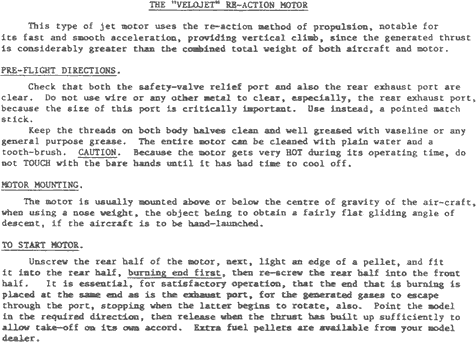
|
 Back of the Velojet instruction sheet, with its repeated warnings
- John Reid
|
|||
|
|
||||
|
|
|
|||
|
|
|
|
|
|
|
|
Acknowledgements - Article: Roger Simmonds - Illustrations: Roger Simmonds, Steve Bage, Brian Benson, Terry Kidd, Hubert Kostrzewa, Ben Nead, John Reid, Mike Stuart |
|
|
|
|
ABOUT | MOTORS | MODELS | ARCHIVE | HISTORY | STORE | FAQ | LINKS |
|
|
Terms of Use
|
Queries? Corrections? Additions?
Please
contact us.
|
|